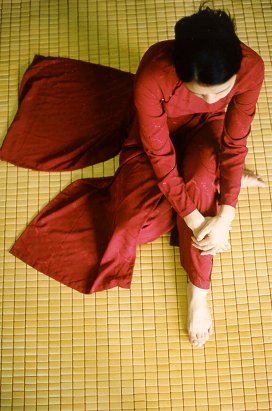
|
Baby and his grandmother
(notice her black dyed teeth)
The Northern tradition of blackening teeth is discontinued. For centuries,
this cultural taste was practiced by Vietnamese women in the North. The
process involved a mixing of sap of the Lac tree with lemon.
A familiar folk song sums up the old standards of feminine beauty in the
following verse: "I love you, first because you are wearing your hair
in a
|
rooster tail; second due to your charming speech;
third, since you've got dimpled cheeks, and fourth because your glossy blackened
teeth exceed jet in their beauty."
Throughout the thousand years of Chinese occupation (1st to 10th centuries)
despite the occupying forces' attempts to force the Vietnamese to adopt
Chinese customs and dress, the Vietnamese refused to stop blackening their
teeth. For these oppressed people, teeth blackening symbolised their cultural
and ethnic distinction ...
|
| Traditional Vietnamese longdress Áo dài
A young Hà Nội lady in the traditional Vietnamese áo dài or long dress.
Áo dài, a full-length, high-necked tunic slit to the waist and worn over
satin pants.
Early versions of the áo dài date back to 1744, it is the national costume
for ladies ...
|

|

|
Traditional Vietnamese conical hats or Nón Lá
The most aesthetic conical hats come from Chương village in the north, and
Huế in central Vietnam.
Traditional designs such as pagodas, birds, flowers are inserted between
the layers and when the hat is held up to the light, these motifs appear
subliminally inspired ... |
 |
Traditional Vietnamese dish or Bánh Chưng
Bánh Chưng or square rice cake is a traditional Vietnamese dish most
commonly found during the New Year celebration Tết .
Every Vietnamese family must have Bánh Chưng among their offerings to
be placed on the ancestors' altars.
One or two days before Tet, the family gather to prepare and cook the
rice cakes around the warm fire. Bánh Chưng is made of glutinous rice,
pork meat and green bean paste, and is wrapped in a square of "Dong"
leaves (rush leaves) giving the rice a green color after boiling for ten
hours.
Making the dish requires care and precision. The rice has to be soaked
in water for an entire day, the pork meat must include skin and fat,
the green beans must be of the same size and the leaves must be fresh.
Squaring off and tying the cakes with bamboo strings require skillfull
hands.
During Tết New Year, the rice cakes are served with "giò lụa"
or lean pork pie, and "hành muối" or salted sour onions ...
|

Chewing a quid of betel or Ăn trầu
A group of village's elderlies gather to delight themselves in chewing a
quid of betel.
A betel chew is made up of several ingredients: betel leaf, slivers of the
arena palm nut, and a lime paste. The pieces of nut covered with lime paste
are wrapped in a leaf, making a tiny package that fits neatly into the cheek
pouch. The quid, as the entire package is called, contains a mild stimulant
and an anesthetic that relieves toothaches while simultaneously suppressing
the appetite ...
|

|
Silk of Hà Đông
Silk fabrics being hanged and stretched (with flexible wooden spikes) to
dry outdoors after weaving.
Hà Đông city, in the south of Hà Nội municipality, is known for its Vạn
Phúc silks. The memory of the patron saint of weavers, Lê Thị Nga, has been
venerated in this city since the 11th century ... |

|
* All lyrics and pictures by Tâm Tiến Nguyễn
Photographer Tâm Tiến Nguyễn
Born and raised in Saigon, Tâm immigrated to the U.S.
in 1978. He picked up his first camera in 1981 as a hobby.
His influence in photography came from his father Nguyễn Huy Trực who is one
of the pioneers in the Vietnamese photography industry along with many other
famous and legendary Vietnamese photographers such as : Nguyễn Mạnh Đan, Nguyễn
Cao Đàm, Trần Cao Lĩnh, Nguyễn Văn Thông, Phạm Văn Mùi.....
Mr. Trực, a former executive in the Pharmaceutical business, served as Chairman
of the Vietnamese American Photography Society in Saigon from 1963-1975, and
he was also General Secretary of the Photographic Society of Vietnam from 1957-1975.
Photography still remains a hobby to Tâm as he regularly returns to Vietnam
to travel throughout the country and to photograph its beauties. He uses a Nikon
F3T, a Nikon FM2, a Sony DSC-S85 and Kodak films. Tâm, a SJSU alumni *, resides
in San Jose, California.
* San Jose State University graduate
Please click at this link to visit his website www.nguyentientam.com
Cái Đình - 2003






